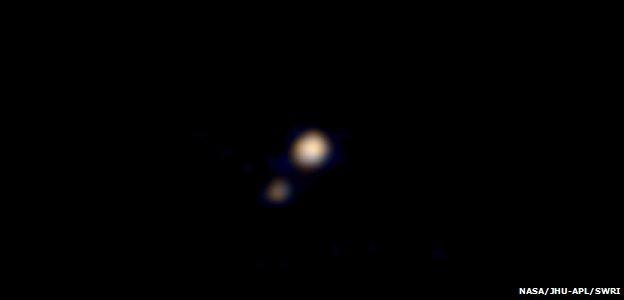Coloured Pluto comes into view
- Published

New Horizons was 115 million km from Pluto (larger sphere) when its Ralph camera captured the view
The New Horizons probe, which is bearing down on Pluto, has captured its first colour image of the distant dwarf planet.
The picture, just released by the US space agency, shows a reddish world accompanied by its biggest moon, Charon.
is set to barrel past Pluto on 14 July.
It will acquire a mass of data that it will then return to Earth very slowly over the course of the next 16 months.
At the current separation of nearly five billion km, it takes 4.6 hours for radio signals to come back. And the bit rate is painfully small.
But the encounter is set to be the major space event of 2015. It will complete the reconnaissance of the "classical nine" planets of our Solar System; New Horizon's flyby will mean every one has been visited at least once by a space probe.
However, not since Voyager 2 passed Neptune in the late 1980s has a new world been revealed up close in the same way as will occur in mid-July.
Today, our best pictures of the 2,300km-wide Pluto come from the Hubble telescope. They are just blobs that make it very hard to discern anything of scientific certainty.
But from May, this will change, as the approaching New Horizons spacecraft starts to return pictures that begin to better in resolution anything Hubble has managed.
Tuesday's release merely whets the appetite. The picture was acquired by the spacecraft's Ralph colour imager on 9 April.
New Horizons was 115 million km - roughly the distance from the Sun to Venus - at the time. Even at this distance, it is possible to resolve some differences in appearance between the dwarf and its moon. One seems brighter than the other.
When New Horizons flies by Pluto on 14 July, Ralph will deliver colour images that show surface features as small as a few km across.
"The spacecraft is in perfect health; it's full of fuel; and it's carrying a scientific arsenal of seven instruments that are - combined - the most powerful suite of instruments ever brought to bear on the first reconnaissance of a new planet,ā enthused Alan Stern, New Horizons' principal investigator.
"Nothing like this has been done in a quarter of a century and nothing like this is being planned again by any space agency.
"This is a real moment in time for you to watch us turn a point of light into a planet."
Jonathan.Amos-INTERNET@bbc.co.uk and follow me on Twitter:
- Published5 February 2015
- Published25 January 2015